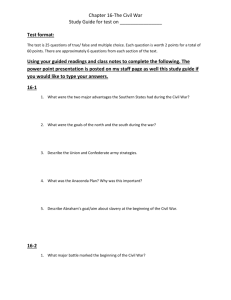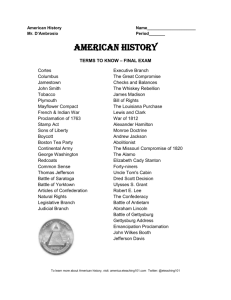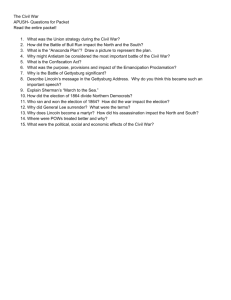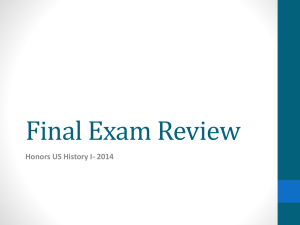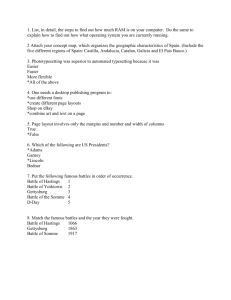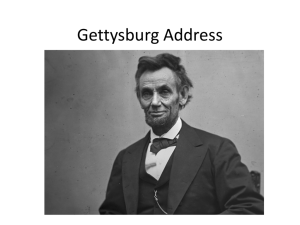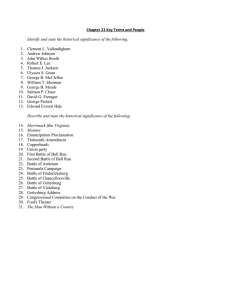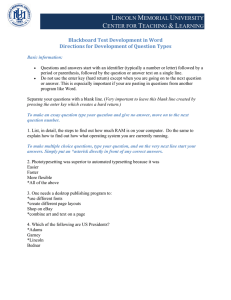Document 13295188
advertisement
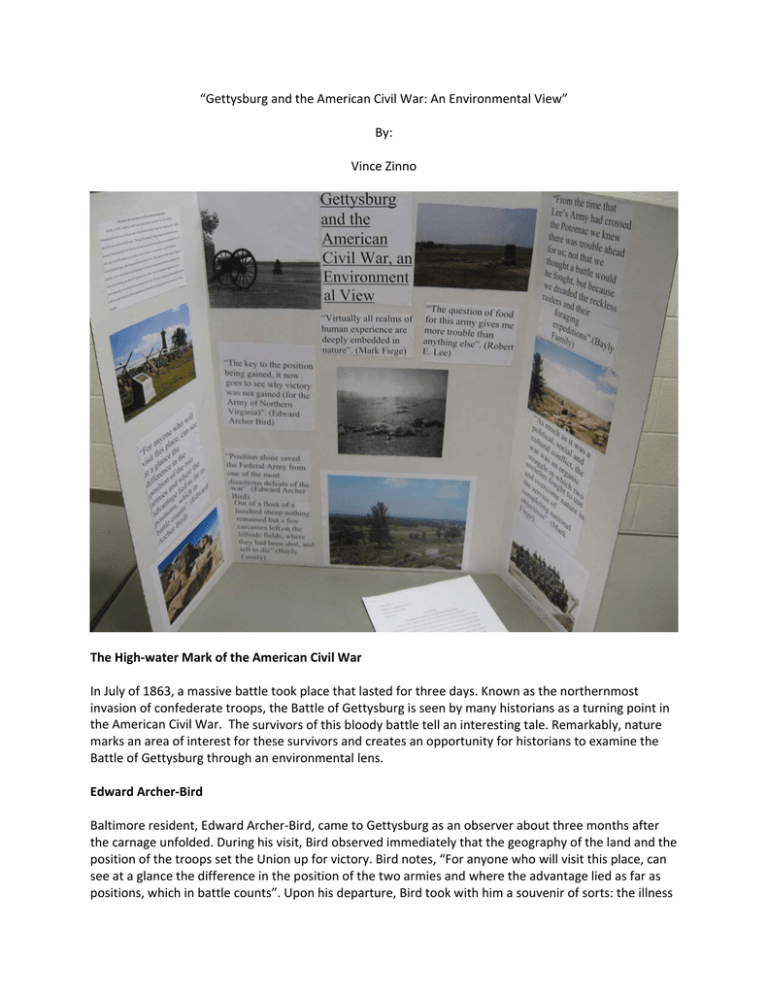
“Gettysburg and the American Civil War: An Environmental View” By: Vince Zinno The High‐water Mark of the American Civil War In July of 1863, a massive battle took place that lasted for three days. Known as the northernmost invasion of confederate troops, the Battle of Gettysburg is seen by many historians as a turning point in the American Civil War. The survivors of this bloody battle tell an interesting tale. Remarkably, nature marks an area of interest for these survivors and creates an opportunity for historians to examine the Battle of Gettysburg through an environmental lens. Edward Archer‐Bird Baltimore resident, Edward Archer‐Bird, came to Gettysburg as an observer about three months after the carnage unfolded. During his visit, Bird observed immediately that the geography of the land and the position of the troops set the Union up for victory. Bird notes, “For anyone who will visit this place, can see at a glance the difference in the position of the two armies and where the advantage lied as far as positions, which in battle counts”. Upon his departure, Bird took with him a souvenir of sorts: the illness dysentery. A month after the battle, the environmental conditions were still very poor, and disease was easy to catch. The Bayly Family Residents of Gettysburg, the Bayly family expected trouble from the confederate forces after they crossed the Potomac. Mrs. Joseph Bayly predicted that the fertile land would attract foragers and starved southern raiders. Her prediction proved correct, as the Rebel forces came into the town demanding food and livestock. Mr. Bayly observes, “The demand for food was constant; all the chickens were killed by the foragers, and most of them brought to the house to be cooked. Out of a flock of a hundred sheep nothing remained but a few carcasses left on the hillside fields, where they had been shot, and left to die”. The confederate army raided and changed the land of Gettysburg in three short days. The outcome of the battle was in relation to the nature and geography of the land, as well as the decision by the rebel army to push north to feed their army. Nature was a contributing factor during the Gettysburg campaign. Vince Zinno Seminar of Comparative History Professor Dieterich-Ward April 8, 2009 Seminar Paper Gettysburg, the American Civil War, and the Environment In July of 1863, a massive battle took place lasting only three days that will be remembered for the rest of time as one of the bloodiest battles fought on American soil. Many died but some lived to tell the story. Through the passing of time, much knowledge has been attained concerning the Civil War but not much can be seen through an environmental lens. To fully take in all the aspects of a certain event in history, it is necessary to see it through a nontraditional means, that being an environmental view. The purpose of this is quite simple; to present a very well defined understanding of all the environmental problems and factors that came about during and after the American Civil War. Also, to realize the significance and importance the environment has on almost any event. The use of primary and secondary sources will be at the forefront of the argument and will assist in making the points relevant as well as logical. The environment has been a key component to just about everything in this world. Wherever we look, as historians, we can find a way to explain the course of events through the environment. Although some may argue that the environment cannot be the root cause of events throughout history, I would beg to differ. In this paper, I plan to examine several works pertaining to the environment and its effects of and from the American Civil War. First is a chapter from the book Natural Enemy, Natural Ally, titled “Gettysburg and the Organic Nature of the American Civil War”. This exert was written by Mark Fiege and through my research it seems as though his works are very well known and credited. The next work to be examined and compared is written by Jack Temple Kirby, a historian from Miami University of Ohio, entitled “The American Civil War: An Environmental View”. And finally, “Environmental History and the American South”, in which a couple exerts were taken to help evaluate environmental change overall in the southern US. These works together build a strong framework for understanding not only environmental effects of the Civil War, but also should give a much better understanding of how this concept applies to the rest of the world and its history. In this passage, Fiege emphasizes how the commanding General of the Army of Northern Virginia, Robert E. Lee, felt that food was one of the biggest environmental factors contributed to the war. A direct quote from Lee “The question of food for this army gives me more trouble than anything else” I think just about says it all. If one really breaks it down and thinks about it, as Fiege suggests, everything that an army needs whether it be food, or weaponry it eminently has come from the Earth. “As much as it was a political, social, and cultural conflict, the war was an organic struggle in which two societies fought to use and overcome nature in the service of competing national objectives”. This quote to me says it all. When looking at it from this perspective many doors of perception are opened and understood in an entirely different light.1 As Fiege points out, very importantly, the environment can be used to explain many factors within a specific war or battle and not limited to the civil war. For example, he believes states that the main reasons for Lee’s march north in the late spring and early summer of 1863 can be contributed mostly to the environment. The south, as a whole, but mainly Virginia at the 1 Mark Fiege. Natural Enemy, Natural Ally. Gettysburg and the Organic Nature of the American Civil War. time was extremely effected in many ways. Landscape was desecrated, and could not supply food, materials, and virtually and animal power that was drastically needed to continue the war. Since the northern landscapes were untouched by Southern rebels, it was the only logical place to go to obtain goods to fuel the cause. Since this war was within a country it took on a much fiercer mentality than others, which inevitably allowed for massive destruction of landscapes, town’s cities, livestock amongst many other things. Fiege also makes clear the outcomes that led to events happening much differently than they could have originally panned out. For example, the battle of Gettysburg in Pennsylvania fits the description quite well. As many know, the Army of the Potomac had control of Gettysburg and the surrounding areas. The landscape of these areas were very much in favor of them due to elevation( obtaining the high ground), many rocky boulders that were between the armies, and sufficient amounts of food to fuel the army. General Longstreet, who was a consultant and aid to Lee, believed that the fortifications were too strong to attack head on and wanted to position the army in a way that they would have the advantage. Lee didn’t see this in the same light and decided that it was time to attack and pursue the enemy. Many criticize Lee for this due to the horrid outcome that followed. His army was virtually devastated and there return to Virginia marked a loss of their main goal (obtaining food and supplies from the rich northern landscapes and towns). But Fiege would argue, and I agree, that Lee believed that his army could wait no more for the resources they so badly needed to obtain. He felt that they marched all the way from Virginia to get the resources and didn’t have time to wait it out per say. “We were unable to await an attack, as the country was unfavorable for collecting supplies in the presence of the enemy, who could restrain our foraging parties by holding the mountain passes with local and other troops”, Robert E. Lee. So the importance of landscape and environment, in a sense, is very critical in the aspect of war and the rest of the world. “Virtually all realms of human experience are deeply embedded in nature”, Mark Fiege.2 To move on to the next work, done by Jack Temple Kirby, there are many similarities in the approach, but also many differences. Kirby seems to have a bit more focus when examining some of the key individual parts of the environment that are factors of and from the Civil War. For example, his work is broken into a couple different sections that contain subsections in order to obtain a full understanding of the broader picture by taking every independent piece and fitting them together. This method I feel is very effective in creating understanding by means of categorizing the information organizationally in your head. He states that “recent historiographies of the war and the “environment” are so curious because they are parallel; that is, they don’t intersect.”3 This I feel is a positive framework for understanding the big picture. If you are to understand everything those two elements must intersect. He also points out that the Civil War has virtually been untouched by Historians in an environmental sense. “Nature sometimes presents change without human agency, but human action—making civilizations, technology, and warfare has enormous consequences”.4 Whether those consequences are positive or negative is not important but realizing the reasoning behind it is. Kirby separates his environmental factors into categories of “Disease”, “Death”, “Animals”, “Cities” and “Towns”, “Farmland”, and “Trees and Forests”, all having important roles in the overall outcomes. I feel this system makes it very clear to comprehend. Unlike Fiege, it seems Kirby puts disease and death at the forefront. He speaks about how condensing 2 Ibid. 3 Jack T. Kirby "The American Civil War: An Environmental View." (2001). National Humanities Center 4 Ibid. the population, like done during war, was a major contributor to the spread of disease. Also, with massive amounts of dead bodies, humans, and animals, battlegrounds became a major transmitter of disease. He later speaks about some of the long term environmental effects that came of massive death tolls during the civil war in the American South. It completely destroyed and unbalanced the distribution of males and females for at least a generation Kirby states. This in turn limited marriages, and more importantly economic prosperity and growth in the region. With less people there was less of an opportunity for technology to advance. This can be related to the Chinese on the midst of an industrial revolution roughly some two hundred years before Europe. The high ranking and powerful Chinese dynasties at the time didn’t want this kind of change and were known to capture and kill off many scholars and thinkers of the age in an attempt to keep control of society. It was also known that they destroyed many documents used for advancement including ancient works from Greece and its surrounding areas.5 Another key element that I thought Kirby included was located in his fifth section, titles Farmland. Much farmland was destroyed by many things during the civil war. Houses, barns, outhouses, were blown to pieces by canons and other means of weaponry. Kirby also states that if the houses and fences were not totally destroyed by a battle itself, they were ripped down and used for firewood on both sides of the war. In the long run, this caused much more change than one would think. “Some excellent farmland” as Kirby points out was lost forever to military cemeteries, destructed lands, and battlefield parks. Although this land is used now to honor those who fell before us, it was not the original usage of that land. In some eyes, it can be seen as a disaster. Also, due to the destruction of a lot of land in the south, it led to many changes in the Post Civil War Era. The landscape was drastically effected due to deforestation and 5 Ibid. spreading of crops that countered the destruction of the war. Cites needed rebuilding, and the lands needed it as well and a way to obtain that became ripping down forests and swamplands in attempt to get back to normal. This may have been a solution at the time but in the long run made the American landscape in the south suffer tremendously.6 In the last text I examined Lisa Brady writes on the topic- The Wilderness of War, Nature and Strategy in the American Civil War. “The wartime relationship between humans and nature is a complex arrangement, characterized sometimes by collaboration, at others, by adversarial competition”.7 This is a strong basis for Brady’s overall subject of analysis in this exert of the book. She talks about how, like Fiege and Kirby, “both the Union and Confederates attempted to overcome nature’s obstacles as they fought to defeat there human foes”.8 This to me shows just how important the environments role was in the American Civil War. She emphasized the importance of landscape in this war and that it was most definitely not in the background of what was going on at all. Like Feige talking about the reasons for Lee’s important decision at Gettysburg, Brady speaks of the importance the landscape ultimately had on military decision making during the course of battle. A perfect example of this was found in the opening pages of the text. Nature played a huge role in decisive battles in the Civil War. In such places as Vicksburg, Mississippi, the Carolina’s, Georgia, and the Shenandoah Valley of Virginia, nature actually became a bigger target then the enemy itself Brady points out. The Union Army “focused not on overcoming 6 Ibid. 8 Paul Sutter, and Christopher J. Manganiello. Environmental History and the American South. University of Georgia P, 2009 nature as an object, but on destroying the enemies’ primary relationship to the natural world”.9 This was primarily done by capturing resources and destroying agriculture in an attempt to cut off supplies any way possible. This to me seals the controversy of how much influence does the environment really have on issues such as war.10 Another important factor I felt Brady discussed was military historians input to historical events. She talks about how they are almost environmental historians but lack a more cultural and traditional mindset needed for the bigger picture. She actually references Kirby when he speaks of how military historians fail to connect the geography and other environmental issues to the rest of the information of an event we already have. It’s like stating that the temperature outside was 100 degrees on October 17, 1865, but forgetting to mention that four people died in the process. No piece of information is too small to obtain a larger view.11 So to wrap up, all of these sources, books or articles, have presented very informative outlooks on the environment and its direct effect on the American Civil War. In all their own ways, their point got across to me and definitively have aided me on the deeper understanding of the effects of nature and environment. But in saying that, I do believe that there is some information and angles that need to be pursued in order to completely grasp nature and the environments role in war; like going into deeper analytical research on specific events in the past. To assist this process, a step back in time of almost a hundred and fifty years seems like a good place to start. 9 Ibid. 10 Ibid. 11 Ibid. Edward Archer Bird, The Bayly Family, and Environmental Civil War in America I have chosen a couple of stories that I found through extensive research that I feel are very essential to my topic of war and the environment. In order to present the information to the best of my ability, I have taken accounts of the battle of Gettysburg from two sources. One is from the town of Gettysburg, and the other is simply visiting the site soon after the bloody battle. By the end of this research it will be clear to see just how prevalent and important environmental events were to shaping history as we know it today. No matter how small a detail it cannot be left out or simply looked over. To start off, I looked deeply at the accounts of a man named Edward Archer Bird. Bird was known to have been from Baltimore, Maryland and had lived there as early as 1849. No records could be found to prove he was there any earlier before that but it doesn’t rule out the possibility. It also is not clear what his profession may be but from the vivid descriptions and immense knowledge shown in the text, I would say he was very well educated and may have been a historian of some sort. Bird starts out his journey from Baltimore with the intention of seeing Julian Buton, a woman friend of his, in Gettysburg and in the process plans on visiting the battlefields. During the trip he doesn’t stop much except in Hanover to sleep but continues on and finally makes it to Gettysburg roughly a month after the carnage unfolded.12 Once in the town, his descriptions of the various points in the battlefields point to the environment in all ways possible. The thing that fascinated me most was his immediate reactions to the landscape of the battle. Right away it became clear to Bird just why the events played out the way they did. He wrote about the enormous rocks in the region that lied near the 12 Edward Archer Bird, Historical Narrative. The Brake Collection (1863) AHEC, Carlisle, PA. pgs 1-3. foot of the Big and Little Round Top’s, and the massive amounts of dead horses that still lay in those desolate fields. Bird then goes on to write about more degradation along the lines of the cemetery in town. He stated that many tombs and monuments were ripped down or broken, some for the purpose of defense of shots and shells. What else could be uncovered from this insightful trip to Gettysburg? Well it turned out to be much more. As Bird continues through the battle fields he arrives at one of the most pivotal locations of the three day escapade, Little and Big Round Top. It was here that his observations came into play most. To quote Bird directly pertaining to the edge the Federal army had due to landscape “The key to the position being gained, it now goes to see why victory was not gained (for the Army of Northern Virginia).”13 The Rebels kept driving up the hill and the Yankees persisted to continue to mow them down. It seemed all too easy Bird thought for the Yankees to prevail under these environmental factors. As I continued to read it became very clear that this was more than a battle between two enemies, but both sides were also battling the landscape. “For anyone who will visit this place, can see at a glance the difference in the position of the two armies and where the advantage lied as far as positions, which in battle counts”.14 This in Bird’s mind was one of the biggest reasons the battle turned out the way it did. At first the Federal Army was outnumbered and risked the chance of a major loss in the town that could have drastically changed the course of the war and America as we now know it. It wasn’t until later that night and into the next morning (Wednesday into Thursday) that reinforcements arrived to help fight off the Rebels. 13 Ibid. pgs. 2-3 14 Ibid. pgs. 4-6 To take another quote from Bird that I feel most completes my point is “Position alone saved the Federal army from one of the most disastrous defeats of the war”.15 Position on the landscape was very essential to the Union victory and it is seen everywhere you look. Bird visited the place roughly a month after the battle and was able to see it immediately. Even more impressively when I visited Gettysburg today I still came to the same conclusion at just a mere glance. Environmental effects and outcomes can be seen all over the place, one just has to open there eyes enough to see them. The Federal position of the high grounds in Gettysburg was able to completely monitor the movements of the Confederate Army in all directions. Bird continued his exploration and came to a devastating conclusion. In his estimation the battlefield entailed a space of about fifteen or twenty miles over which one could not pass over any portion without coming across the graves of the fallen soldiers. Not only were thousands upon thousands of people dead, but the landscape was drastically changed forever. Farms became graveyards, fences became products of small fires for cooking, livestock were captured or killed, and many houses became the product of wars nasty devastation. “Many of the houses in Gettysburg, especially in the southern part, are perforated with minnieballs and in some cases shells”.16 Confederate sharpshooters were known to have posted up in a house and were systematically picking off Federal troops. Shortly after, their position was found and unfortunately the house was shelled to nothing more than rubble. Just as unfortunate as the battle itself, a part of the battle actually hit Edward Bird in a way that was most ill-fated. From being in Gettysburg for just a week he contracted an attack of dysentery and diarrhea. It seemed as though disease was still running rampant in the area even a 15 Ibid. pgs. 6-7 16 Ibid. pgs. 9-10 month after the battle took place. From this one can draw many conclusions about health in the region and what it may be contributed to. With massive casualties of humans and animals, the ecosystem was left in shambles for quite some time. I wouldn’t be surprised if many civilians died or at the very least became ill just from being in the general area of the town. By Tuesday August 25, 1863, Bird had seen enough of Gettysburg and by late afternoon had started his journey back to Baltimore. His insights and evaluations of the battle and landscape really show how important it was in the scheme of things.17 Moving on to the next topic, the gears of perception are in motion and a whole different outlook of the war will be closely examined. The story told next comes from a quiet family that lived in the town of Gettysburg during the battle. This account shows the hardships that came along for civilians in the area at the time, and also some of the environmental effects that desecrated the area. The account comes from Mrs. Joseph Bayly, mother of William Hamilton Bayly, and her immediate family. The problem with environmental issues is seen almost immediately in her writings and she seems to try to find a way around it the whole time. “From the time that Lee’s Army had crossed the Potomac we knew there was trouble ahead for us; not that we thought that a battle would be fought, but because we dreaded the reckless raiders and their foraging expeditions”.18 Right out of the shoot the Bayly family knew that they were going to have a lot of trouble with the landscape of their property and the commodities they had on it. With the Confederates moving north to live off the land due to the destruction in the south, many knew that there environment would be changed as they knew it. 17 Ibid. pgs. 8-11 18 Mrs. Joseph Bayly. Story of the Battle of Gettysburg. Civilian Manuscripts from Gettysburg (1863) AHEC, Carlisle, PA. pg. 1. Mrs. Bayly begins talking about how all the neighbors couldn’t stop talking about what’s going on or what may happen to them. As she walked down Chambersburg Pike she ran into some Yankees who were anticipating a battle soon and not a minute after that shells could be heard from roughly a mile away. She then saw what seemed to be thousands of Rebel soldiers coming in her direction which made her turn back and run for her house and children. As she returned home, confusion had set in big time at her house and her immediate neighbors. It seemed as though there problems had heightened severely. Rebels were demanding food and rations along with wanting to know where their livestock was. Of course this would be devastating to the family if there food source, and labor source was extinguished like a fire to the Rebels. At first the Confederates tried to take the horses, but since they were not tied up they had a lot of trouble and eventually gave up Mrs. Bayly writes. Also, she makes it clear that these escapades were not a onetime deal by any means. “The demand for food was constant; all the chickens were killed by the foragers, and most of them brought to the house to be cooked. Out of a flock of a hundred sheep nothing remained but a few carcasses left on the hillside fields, where they had been shot, and left to die”.19 This statement says it all. The Rebel destruction of the landscape through military force was not simply the only means of damaging society. It was clear that society was being destructed in the process. With no food, or animals to eat or sell, there was no money for the family which meant constant grief and suffering. How could all this unfold in just three days? Even more cases of environmental change and disruption are seen with the Bayly family’s cattle. Mrs. Bayly said that they were able to hide some cattle but the ones that were 19 Ibid. pg. 1. just ready for the market were taken almost immediately. And it didn’t stop there, Confederate soldiers made them cook and bake all day long and swarmed the place until there stomachs were full. Although most of the essentials of and from the land were taken from the Bayly family, some items were able to be salvaged. “We had hidden about thirty barrels of flour under a pile of stive wood in the wood shed. This was not found. There was enough left outside to keep us busy baking for three days, and the hams and other meat went with the rest”.20 From this quote it’s easy to see just how much of an impact the Confederates had on the landscape and environment of Gettysburg in such a short period of time. She then goes on to explain some of the sights that she saw on the battlefield of the first day’s aftermath. As she rode through she thought “As far as I could see there were men, living and dead, and horses and guns and cannon, and confusion everywhere”. Mrs. Bayly points out that she could go on indefinitely about the incidents that occurred with her and her family pertaining to Rebel foraging. The most devastating event for the family actually came about during the last bit of the battle just as the Rebels were deciding to ultimately retreat. Their tamed horses, along with the colts that were not tied up were taken under possession of the Confederate Army. This was yet again another environmental factor that contributed to the destruction and disruption of the area. One horse named “Nellie” had a great deal of sentimental value to the family considering it had belonged to Mrs. Bayly’s only daughter, who had recently died. Originally the Rebel soldiers agreed to leave that one and told the family to lock it up on the basis of a good dinner being 20 Ibid. pg. 1. cooked for them. But not a half hour later that same soldier returned with direct orders to confiscate the horse. Through thick and thin though, the Bayly family survived the onslaught of circumstances thrown at them in those three crucial days in Gettysburg. They went to sleep and as Mrs. Bayly said, “Awoke the next day to find the battle was over, the victory was won and our homes once more in our peaceful possession”.21 In conclusion, I believe that all of the information within has showed just how much of an impact the environment and the surroundings had on the Battle of Gettysburg. Not only did this event significantly affect the war, but they also had a major influence on civilians. From these examples and accounts it is clear to see that everyone and everything is affected by the environment and its changes. Bird analyzed the scene and found terrible detrimental effects, while Bayly experienced problems first hand for three days straight. Feige showed us the importance of natural resources to the Confederates while Kirby categorizes environmental factors and problems associated with the Civil War. By looking at these many different perspectives of the battle, along with analysis of detrimental effects, I honestly can say that I have a better understanding of just how important seeing these effects in history really is. 21 Ibid. pg. 2. Vince Zinno Dr. Dieterich-Ward Seminar in Comparative History April 30, 2009 Self Assessment Historiographical Essay Over the course of my collegiate career, I have made many mistakes but also have a great deal of things to be proud of. I first started out at Montgomery County Community College near Philadelphia which is where History as a major for me began. I’ve taken a variety of different history classes and have built a great deal of knowledge up over the course of time. At the beginning, I decided to pursue history for the sheer fact that it was easy for me and because was for the most part very lazy. But after time started to pass, I started to realize that history had much more significance to me then just being easy. It explained things and opened new doors for me at every chance it got. When I made it to Shippensburg about two years ago, History transferred from being just my class work to my life. I have been privileged to learn many things along the way that will be with me for the rest of my life. As I said in the introduction, I have made mistakes and also have done, in my mind, excellent work but the best part for me was how much I learned from my overall experiences. For example, when I was in the Theory and Practice class, we dealt pretty heavily with primary and secondary sources within the field of History. For me, primary sources were kind of new because I was used to reading literature from authors of my time period or at least around it. It was like a whole new world was in my sights and it was my job to fit everything together. We were taught how to interpret primary sources in a way that is not simply reading the words literally. The idea was to read it and take from it what you get from it; in other words there is no one explanation for a single primary source that is better than another. The most important thing that I learned from the class was to interpret history in your own way and that not everything is a fact with history, it’s all subject to interpretation. This opened up a whole new portion of my brain considering how teachers in the past have gone about teaching and explaining history. I have chosen to look at a couple of my papers that I have comprised over the last couple years in order easily see the progress that I’ve made. First, the Seminar Paper that were had to write for this class, next was the final paper for the Theory and Practice class, and finally, a paper I had written for Mrs. Dessants on a book called All Shook Up, How Rock N’ Roll Changed America. When reading over these works it was clear for me to see the progress I’ve made almost immediately. The oldest paper out of the three, All Shook Up, had many examples of a work written by a lower level student. I have many misspellings, which came from me not caring enough to proofread, along with some minor grammar problems. Also, I don’t feel as though I went into enough of a deep analytical framework like I have so recently learned how to do. The paper was solid for the most part, but it wasn’t nearly as fine tuned as what I can create today. The second work to be examined was my final project for the Theory and Practice class that I had with Dr. Burg, who really is and outstanding gentleman. The overall theme for the course was the African American influence and involvement in the American Civil War. We were all assigned to write somewhat of a biography of a specific African American Solider that was buried in the Locust Grove Cemetery located on Queen Street in Shippensburg. This project by far was one of the most interesting out of all the things that I’ve don’t in school at any level. It could just be because of my love for the American Civil War but none the less I had a great experience. I wrote about a man named Joseph B. Robinson, who was a soldier who fought for the Union Army and was a part of Co. B, 25th Regt. Colored Volunteer Infantry. He was a native of Shippensburg and his family lived there during and after the war. For me, a couple parts of the research were very interesting. Specifically, we went to the Shippensburg Historical Society located on King Street. This was a fascinating experience for me in that I got to look at types of records that I never saw before. We examined such things as newspapers, personal accounts, and even got to see maps of Shippensburg and exactly who lived where in the 1860’s. I had never before been exposed to such wonderful information that was right in front of my face. I just had a whole lot of fun with the whole thing and would love to do some research in my own time just for the sheer joy I got out of it. The one thing that I feel could have been included in the curriculum a little more has to deal with primary sources. We were taught how to read, interpret, and understand them, but the biggest problem for me in the Capstone class was not already knowing how to find them efficiently and easily. The final topic for this paper is the Seminar Paper. This paper, and class, like the final paper for Theory and Practice, also opened my mind to a whole new dimension. That dimension in this case was the study of Environmental History. I had never even dabbled in this kind of study before and it was completely new to me. I really do feel in retrospect that they way that you went about teaching the course was the perfect way to do it. We talked a lot in class about how things from the beginning of the semester made more and more sense as the semester rolled on which I thought was great. I truly believe that Environmental History is very important and is a key component to understanding a lot of events throughout history. I’m so glad that I got to take this Seminar class with the topic being what it was because I learned more than I can possibly imagine. Not only did I learn it for the course, but I learned it for myself because of just how interesting it was for me. It’s for these reasons that I’ve decided to take your Environmental History class next semester. Another positive that came from the Capstone was learning how to go about writing a well composed research paper that could be a contributed part of history. I really enjoyed learning how to find primary sources and put them together to construct a final project. I also thoroughly enjoyed going out and doing the research hands on. I went to AHEC for my research and was fascinated beyond belief at what I found while I was there. After I completed my research there I wanted to eat lunch and come right back just to explore the rest of the items they had in the archive. This sort of thing was right up my alley. Fortunately I didn’t run into any problems with retrieving information (Ben going to D.C. for Yellowstone information ha-ha). Also, another thing that I thought was great that came out of the capstone was how useful the guides you gave us along the way were. Like the how to read a book/ article, or how to write a historiography/research paper. Those things and many others helped me more than you could believe with me research. In conclusion, I feel that I have made very significant progress over my scholastic career. I started out not really caring too much and by the end I may care too much. I really enjoy history and all the perks that it has to offer. One of best things that I’ve got out of the history field was how much better of a reader and writer I have become. I used to dread reading and writing and now I sometimes look forward to it. It’s surprising how right your parents were when they said “you’ll understand when you grow up”.
